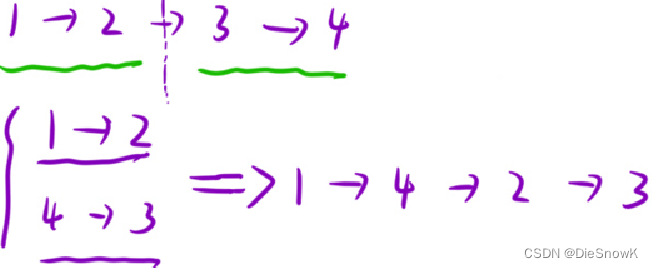目录
0.常用技巧
-
画图 -> 直观 + 形象 -> 便于理解
-
引入虚拟头结点
- 便于处理边界情况
- 方便对链表操作
-
不要吝啬空间,大胆去定义变量
- 简化插入删除的逻辑
- 都是函数内的临时变量,也不会很占用空间:P

-
快慢双指针
- 判环
- 找链表中环的入口
- 找链表中倒数第n个结点
1.两数相加
1.题目链接
2.算法原理详解
- 两个链表都是逆序存储数字的
- 即:两个链表的个位数、⼗位数等都已经对应,可以直接相加
- 在相加过程中,要注意是否产⽣进位,产⽣进位时需要将进位和链表数字⼀同相加
- 如果产⽣进位的位置在链表尾部,即答案位数⽐原链表位数⻓⼀位,还需要再
new⼀个结点储存最⾼位
- 如果产⽣进位的位置在链表尾部,即答案位数⽐原链表位数⻓⼀位,还需要再
3.代码实现
ListNode* AddTwoNumbers(ListNode* l1, ListNode* l2)
{
ListNode* head = new ListNode(0);
ListNode* cur1 = l1, *cur2 = l2;
ListNode* tail = head; // 尾指针
int carry = 0; // 记录进位 & 临时数据
while(cur1 || cur2 || carry)
{
if(cur1)
{
carry += cur1->val;
cur1 = cur1->next;
}
if(cur2)
{
carry += cur2->val;
cur2 = cur2->next;
}
tail->next = new ListNode(carry % 10);
tail = tail->next;
carry /= 10;
}
ListNode* ret = head->next;
delete head;
return ret;
}
2.两两交换链表中的节点
1.题目链接
2.算法原理详解

3.代码实现
ListNode* SwapPairs(ListNode* list)
{
// 边界处理
if(list == nullptr || list->next == nullptr)
{
return list;
}
ListNode *head = new ListNode(0);
head->next = list;
ListNode *prev = head, *cur = head->next, *next = cur->next, *nNext = next->next;
while(cur && next)
{
// Swap
prev->next = next;
next->next = cur;
cur->next = nNext;
// Update
prev = cur;
cur = nNext;
if(cur)
{
next = cur->next;
}
if(next)
{
nNext = next->next;
}
}
ListNode *ret = head->next;
delete head;
return ret;
}
3.重排链表
1.题目链接
2.算法原理详解
- 找到链表的中间结点
- 快慢双指针
- 把后面部分逆序
- 头插法
- 合并两个链表
- 双指针

- 双指针
3.代码实现
void ReorderList(ListNode* head)
{
// 边界处理
if(!(head || head->next || head->next->next))
{
return;
}
// 1.找到链表的中间结点 -> 快慢指针
ListNode *slow = head, *fast = head;
while(fast && fast->next) // 偶 && 奇
{
slow = slow->next;
fast = fast->next->next;
}
// 2.逆序后半部分 -> 头插
ListNode *head2 = new ListNode(0);
ListNode *cur = slow->next;
slow->next = nullptr; // 断开两个链表
while(cur)
{
ListNode *next = cur->next;
cur->next = head2->next;
head2->next = cur;
cur = next;
}
// 3.合并两个链表 -> 尾插 -> 双指针
ListNode *ret = new ListNode(0);
ListNode *tail = ret;
ListNode *cur1 = head, *cur2 = head2->next;
while(cur1)
{
// 先连第一个链表
tail->next = cur1;
tail = tail->next;
cur1 = cur1->next;
// 再连第二个链表
if(cur2)
{
tail->next = cur2;
tail = tail->next;
cur2 = cur2->next;
}
}
delete head2;
delete ret;
}
4.合并 K 个升序链表
1.题目链接
2.算法原理详解
- 思路一:利用堆
- 合并K个升序链表时,可以选择K个链表中,头结点值最⼩的那⼀个
- 那么如何快速的得到头结点最⼩的是哪⼀个呢?
- 小根堆
- 可以把所有的头结点放进⼀个⼩根堆中,这样就能快速的找到每次K个链表中,最⼩的元素是哪个
- 思路二:递归/分治

3.代码实现
// v1.0 Heap
class Solution
{
struct Cmp
{
bool operator()(const ListNode* l1, const ListNode* l2)
{
return l1->val > l2->val;
}
};
public:
ListNode* mergeKLists(vector<ListNode*>& lists)
{
// 创建一个小根堆
priority_queue<ListNode*, vector<ListNode*>, Cmp> heap;
// 让所有头结点入堆
for(auto& list : lists)
{
if(list)
{
heap.push(list);
}
}
// 合并K个有序链表
ListNode* ret = new ListNode(0);
ListNode* tail = ret;
while(!heap.empty())
{
ListNode* tmp = heap.top();
heap.pop();
tail->next = tmp;
tail = tail->next;
if(tmp->next)
{
heap.push(tmp->next);
}
}
tail = ret->next;
delete ret;
return tail;
}
};
// v2.0 递归
class Solution
{
public:
ListNode* mergeKLists(vector<ListNode*>& lists)
{
return Merge(lists, 0, lists.size() - 1);
}
ListNode* Merge(vector<ListNode*>& lists, int left, int right)
{
// 边界情况处理
if(left > right)
{
return nullptr;
}
if(left == right)
{
return lists[left];
}
// 中间点划分数组
int mid = left + (right - left) / 2;
// [left, mid] [mid + 1, right]
// 递归处理左右区间
ListNode* l1 = Merge(lists, left, mid);
ListNode* l2 = Merge(lists, mid + 1, right);
// 合并两个有序链表
return MergeTwoLists(l1, l2);
}
ListNode* MergeTwoLists(ListNode* l1, ListNode* l2)
{
// 边界情况处理
if(l1 == nullptr)
{
return l2;
}
if(l2 == nullptr)
{
return l1;
}
// 合并两有序链表
ListNode head(0);
ListNode *cur1 = l1, *cur2 = l2, *tail = &head;
while(cur1 && cur2)
{
if(cur1->val <= cur2->val)
{
tail->next = cur1;
tail = tail->next;
cur1 = cur1->next;
}
else
{
tail->next = cur2;
tail = tail->next;
cur2 = cur2->next;
}
}
if(cur1)
{
tail->next = cur1;
}
if(cur2)
{
tail->next = cur2;
}
return head.next;
}
};
5.K 个一组翻转链表
1.题目链接
2.算法原理详解
- 思路:
- 按k个一组,分出需要逆序多少组
- 遍历链表求出n
n /= 3
- 重复n次,长度为k的链表逆序即可
- 按k个一组,分出需要逆序多少组
3.代码实现
ListNode* ReverseKGroup(ListNode* head, int k)
{
// 遍历求n
int n = 0;
ListNode* cur = head;
while(cur)
{
n++;
cur = cur->next;
}
n /= k;
// 重复n次逆序长度为k的链表 -> 头插
ListNode ret(0);
ListNode *prev = &ret;
cur = head;
while(n--)
{
ListNode *back = cur;
for(int i = 0; i < k; i++)
{
ListNode* next = cur->next;
cur->next = prev->next;
prev->next = cur;
cur = next;
}
prev = back; // 更次每次头插的"头"
}
// 链接剩下的结点
prev->next = cur;
return ret.next;
}






















 352
352











 被折叠的 条评论
为什么被折叠?
被折叠的 条评论
为什么被折叠?










